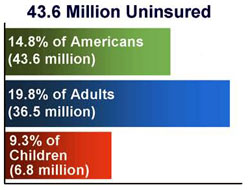CDC Features
Current Features
Uninsured Americans: Newly Released Health Insurance Statistics

Health insurance coverage improves access and quality of medical care and can contribute to the overall health of Americans. According to 2005 data from the National Ambulatory Medical Care Survey and the National Hospital Ambulatory Care Survey1,

SOURCE: National Health Interview Survey, 2006
• The visit rate for patients with no insurance was about twice that of those with private insurance in emergency departments.
• Conversely, patient visits to physician offices were higher for individuals with private health insurance compared to those with no insurance.
Other recent data on health insurance from the National Health Interview Survey2show slight increases in uninsured adults:
• In 2006, 14.8 percent of Americans, or 43.6 million, were currently without health insurance.
• Among working-age Adults (those ages 18-64), 19.8% did not have health insurance in 2006, an increase in the percent uninsured from 18.9% the year before.
• Approximately 9.3% of children under the age of 18 did not have health insurance in 2006, a non significant increase in the uninsured from 8.9% in 2005.
Data from 20063also show differences in percentage uninsured by race and ethnicity:
• Almost a third (32.1 percent) of Hispanic people were uninsured when interviewed in 2006.
• While 10.4 percent of non-Hispanic white persons and 15.9 percent of non-Hispanic black persons were uninsured when interviewed.
A person was defined as uninsured if he or she did not have any private health insurance, Medicare, Medicaid, State Children’s Health Insurance Program (SCHIP), state-sponsored or other government-sponsored health plan, or military plan. A person was also defined as uninsured if he or she had only Indian Health Service coverage or had only a private plan that paid for one type of service such as accidents or dental care.
To learn more about other topics, visit the Data and Statistics page for more survey data, tools, and other resources from across CDC.
More Data and Statistics
For more health insurance statistics, please see:
- Health Insurance Coverage: Early Release of Estimates from the National Health Interview Survey, 2006 (
 352 KB)
352 KB) - The health insurance coverage data from the Early Release Program of the National Health Interview Survey. The Early Release Program provides the most up-to-date national statistics.
- Ambulatory Medical Care Utilization Estimates for 2005 (
 252 KB)
252 KB) - The health care coverage questions for national and state estimates from the Behavioral Risk Factor Surveillance System.
1 Ambulatory Medical Care Utilization Estimates for 2005 PDF (352 KB)
2 Health Insurance Coverage: Early Release of Estimates from the National Health Interview Survey, 2006 PDF (16 pages, 352 KB)
3 Barnes P, Schiller JS. Early release of selected estimates based on data from the 2006. National Health Interview Survey. National Center for Health Statistics. June 2007.
Page last updated: August 8, 2007
Content sources: National Center for Health Statistics
Content owner: National Center for Health Marketing
URL for this page: www.cdc.gov/Features/Uninsured

